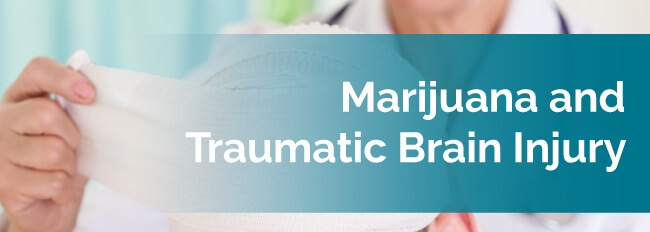
Traumatic brain injuries cause dysfunction of the brain due to an external force. The effects can be severe and long-lasting, with continued damage to the brain even after the initial event. Using cannabis for traumatic brain injury may help minimize the damage to retain more skills and cognitive functioning for improved quality of life.
After a traumatic brain injury, the body can release toxic chemicals that cause further damage to the brain, including excitotoxicity, oxidative stress and inflammation. These processes can cause neural death even after the patient is stabilized, creating much more damage than the initial injury.
Marijuana is known for its protective qualities in the neural system. This means medical cannabis could help minimize the secondary brain damage that happens after the initial injury. The body’s natural endocannabinoid system includes many receptors throughout the body. The cannabinoids in medical marijuana interact with those receptors and may keep the body from releasing cytokines, which cause inflammation, after the injury. Cannabinoids may also encourage the body to release minocycline to minimize swelling and neurological impairment.
Find A Doctor Find A Dispensary
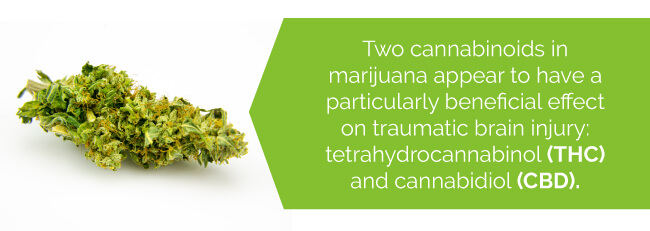
Two cannabinoids in marijuana appear to have a particularly beneficial effect on traumatic brain injury: tetrahydrocannabinol (THC) and cannabidiol (CBD). CBD, in particular, may be effective in treating traumatic brain injury. It is a non-psychoactive cannabinoid, meaning it doesn’t create the “high” effect like THC. It also offers many beneficial properties, including neuroprotective, anti-inflammatory and anti-anxiety effects.
In a study performed on piglets with brain injuries, CBD reduced excitotoxicity, oxidative stress and inflammation. Another study showed significant reductions in brain swelling in mice with brain injuries.
Research by Professor Yosef Sarne at Tel Aviv University shows a positive relationship between cannabis and traumatic brain injury. The research revealed that cannabinoids administered shortly before or one to three days after the injury help protect brain cells and long-term cognitive functions. The cannabinoids seemed to initiate the biochemical processes that create that protective effect.
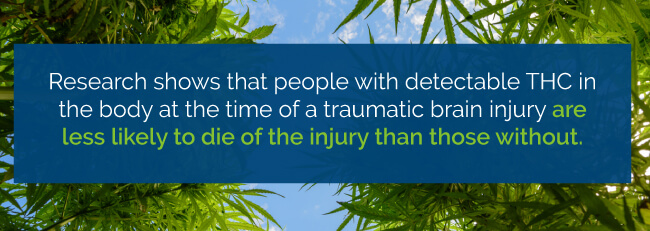
Other research shows that people with detectable THC in the body at the time of a traumatic brain injury are less likely to die of the injury than those without. This data suggests that marijuana may have a preventive effect before the injury occurs. This information aligns with the results of Sarne’s research.
Marijuana also has other benefits that reduce some of the symptoms of traumatic brain injury, including:
Federal regulations limit the amount of specific research on marijuana and traumatic brain injury. Scientists often have difficulty gaining access to the cannabinoids needed to perform meaningful studies due to the regulations. Despite the lack of studies in the U.S., many people share anecdotal evidence of success in treating traumatic brain injury with marijuana.
Choosing a strain of medical marijuana is an important first step in treating your traumatic brain injury. A qualified medical marijuana doctor can help you choose a specific strain for your situation. Both THC and CBD seem to have a positive effect on traumatic brain injuries. In some studies, CBD appears to have an even stronger effect on the brain. Choosing a strain of medical marijuana high in CBD may provide the greatest benefits.
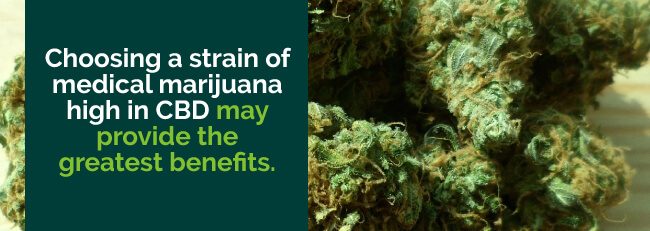
Marijuana is categorized as being Sativa-dominant or Indica-dominant. You can find strains high in CBD in both types. Sativa strains tend to give users an uplifting, energizing effect. This is beneficial if you want more energy or need to stay alert. For help with sleep issues, an Indica strain may be a better option. These strains often make the user feel sleepy, which can help you sleep better.
Ingestion method is another factor in creating your treatment plan. Consider these ingestion methods:
Taking medical marijuana can have a profound positive impact on your traumatic brain injury. However, it’s important to note that cannabis does have some side effects. While those side effects are often mild, knowing what to expect helps you prepare for them.

Some common effects of marijuana include:
Many of the side effects of marijuana can be positive. For example, if you have insomnia, the fact that marijuana leads to drowsiness may help you sleep at night. If your appetite is low, the increased hunger can help you get the nutrition you need. In addition, many users enjoy the high sensation.
Are you or a loved one facing the effects of a traumatic brain injury? Medical marijuana could have a neuroprotective effect to minimize the long-term effects of the injury. We can help you connect with qualified medical marijuana doctors in your area. We have options in all legal marijuana states. Connect with a doctor now to start regaining quality of life after a traumatic brain injury.
For more information about how cannabis can be used to treat Traumatic Brain Injury, check out our resources:
Find A Doctor Find A Dispensary
A traumatic brain injury is damage to the brain due to a bump, blow, jolt or head injury. An object that penetrates the brain can also cause a traumatic brain injury. The injury causes a disruption to normal brain functioning, which can interfere with almost every process in the body. Children and older adults are particularly susceptible to traumatic brain injury, but everyone is at risk. Each year, almost 52,000 people die from traumatic brain injuries, and another 80,000 face severe disability related to the injuries. More than 5.3 million people in the U.S. live with traumatic brain injury disabilities.
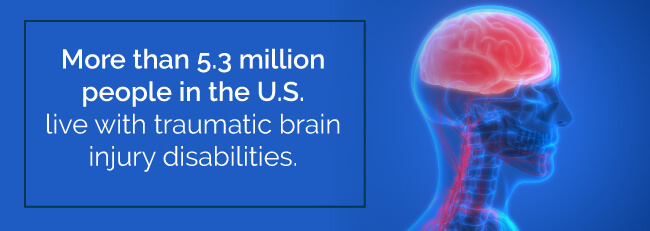
Minor traumatic brain injuries, such as concussions, sometimes cause only temporary dysfunction, while serious traumatic brain injury can cause permanent dysfunction or even death. That long-term damage often comes from bruising, tissue tearing, bleeding or similar injuries inside the brain. In some cases, the damaged brain cells happen only at the point of impact. In severe cases, the brain may move around in the skull, causing damage to cells throughout the brain. Bleeding and swelling as a result of the injury can cause further damage.
After the initial injury, the body often releases chemicals that can have a toxic effect. Those chemicals can cause additional damage following the injury. Even if the patient survives the actual injury, the continued damage can be devastating.
Symptoms range significantly depending on the severity of the injury and the location in the brain. The effects of the injury often include physical, sensory and cognitive symptoms. Some of the symptoms happen initially and go away. Others last a lifetime.
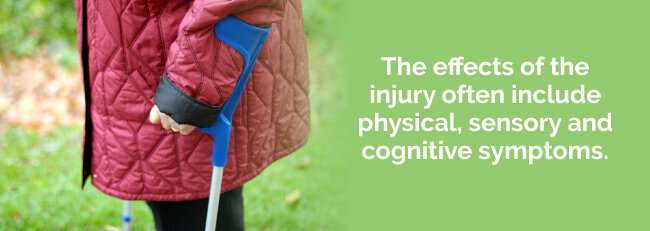
The symptoms of a mild traumatic brain injury may include:
Moderate to severe traumatic brain injuries may cause the following symptoms:
A traumatic brain injury can be more difficult to spot in children, particularly young children without the ability to communicate the symptoms. Parents should be particularly vigilant after a head injury to look for specific signs.
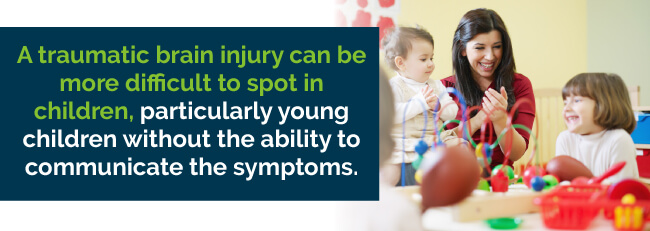
Some symptoms to look for in children include:
Symptoms may appear immediately, or they may be delayed for hours or days after the impact that causes the injury. For this reason, continued monitoring is important any time you receive a blow to the head.
Patients with traumatic brain injuries may face potentially serious complications, including:
Since traumatic brain injury happens due to impact to the brain, most people know the cause and origin of the injury. In many cases, the initial incident requires immediate medical attention to stabilize the situation and prevent further damage or death. Gathering information about the injury helps the physician determine if the patient is at risk for a traumatic brain injury. CT scans and MRIs can help spot issues associated with traumatic brain injury. These imaging tests help the medical team evaluate the severity of the damage and create a course of action.
The type of treatment depends significantly on the severity of the traumatic brain injury. Mild cases may not need any treatment at all. Pain relievers can help ease pain associated with the blow that caused the injury. Regular monitoring is important to ensure the symptoms don’t get worse. This monitoring often happens at home, along with rest to help the brain recover.
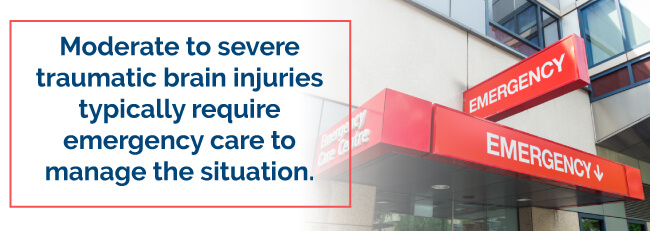
Moderate to severe traumatic brain injuries typically require emergency care to manage the situation. The care ensures the patient is stable, including oxygen supply, blood supply and blood pressure. Physicians also work to prevent any further damage by controlling things such as inflammation and bleeding. Once the immediate danger passes, the medical team creates a long-term treatment plan to help the patient live with the injury as well as possible.
The immediate and ongoing treatment options often include a variety of therapies. Those may include medications, surgery and rehabilitation. Surgery focuses on repairing or minimizing the damage caused by the blow. This may include removing hematomas, repairing skull fractures or making a hole in the skull to allow room for swelling.
Medications used to treat the traumatic brain injury may include:
Once physicians stabilize the immediate injury, patients often need rehabilitation services to regain basic functions and daily activities. The therapy may continue in a rehab facility or on an outpatient basis after the patient gets discharged from the hospital. Patients may undergo different types of therapies at once, depending on the severity of the injury and the impact it has on the person.
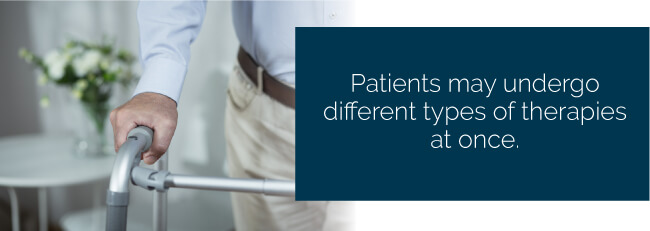
Some people involved in the rehab may include: